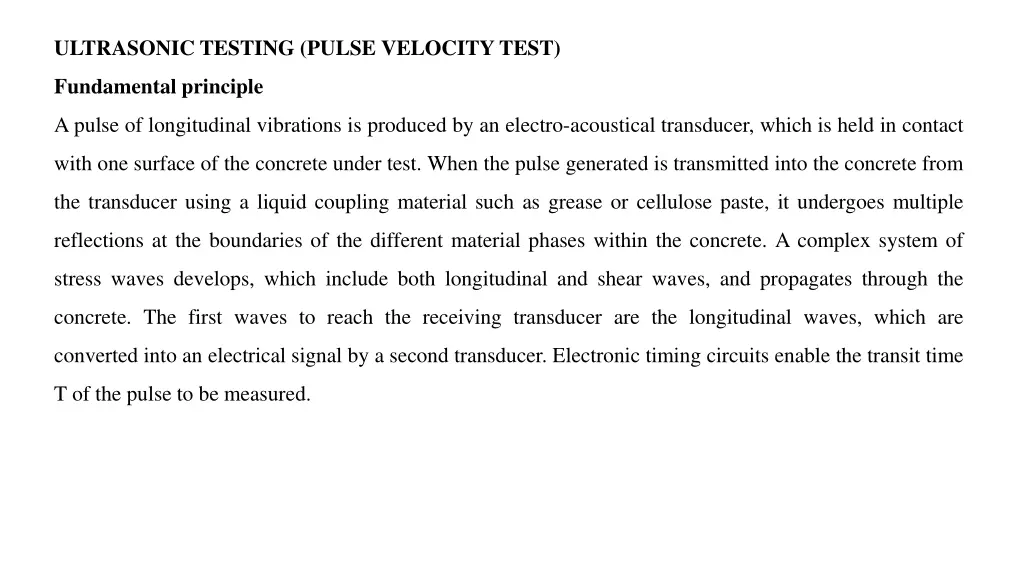
Ultrasonic Testing Pulse Velocity - Fundamental Principle and Applications
Learn about ultrasonic testing pulse velocity, including its fundamental principle, determination methods, applications, and transducer arrangements for measuring the velocity of longitudinal vibrations in concrete. Explore how this technique is used to assess concrete quality, uniformity, and changes over time.
Download Presentation

Please find below an Image/Link to download the presentation.
The content on the website is provided AS IS for your information and personal use only. It may not be sold, licensed, or shared on other websites without obtaining consent from the author. If you encounter any issues during the download, it is possible that the publisher has removed the file from their server.
You are allowed to download the files provided on this website for personal or commercial use, subject to the condition that they are used lawfully. All files are the property of their respective owners.
The content on the website is provided AS IS for your information and personal use only. It may not be sold, licensed, or shared on other websites without obtaining consent from the author.
E N D
Presentation Transcript
ULTRASONIC TESTING (PULSE VELOCITYTEST) Fundamental principle A pulse of longitudinal vibrations is produced by an electro-acoustical transducer, which is held in contact with one surface of the concrete under test. When the pulse generated is transmitted into the concrete from the transducer using a liquid coupling material such as grease or cellulose paste, it undergoes multiple reflections at the boundaries of the different material phases within the concrete. A complex system of stress waves develops, which include both longitudinal and shear waves, and propagates through the concrete. The first waves to reach the receiving transducer are the longitudinal waves, which are converted into an electrical signal by a second transducer. Electronic timing circuits enable the transit time T of the pulse to be measured.
Longitudinal pulse velocity (in km/s or m/s) is given by: v = L/ T where v is the longitudinal pulse velocity, L is the path length, T is the time taken by the pulse to traverse that length. Applications Measurement of the velocity of ultrasonic pulses of longitudinal vibrations passing through concrete may be used for the following applications: Determination of the uniformity of concrete in and between members Measurement of changes occurring with time in the properties of concrete Correlation of pulse velocity and strength as a measure of concrete quality. Determination of the modulus of elasticity and dynamic Poisson's ratio of the concrete.
Determination of pulse velocity 1. Transducer arrangement The receiving transducer detects the arrival of that component of the pulse, which arrives earliest. This is generally the leading edge of the longitudinal vibration. Although the direction in which the maximum energy is propagated is at right angles to the face of the transmitting transducer, it is possible to detect pulses, which have travelled through the concrete in some other direction. It is possible, therefore, to make measurements of pulse velocity by placing the two transducers on either: - Opposite faces (direct transmission) -Adjacent faces (semi-direct transmission): or - The same face (indirect or surface transmission). These three arrangements are shown in Figs. 1(a), 1(b) and 1(c).
FIG. 1(a): Direct transmission. FIG. 1(b): Semi-direct transmission Figure 1(c): Indirect or surface transmission.
2. Determination of pulse velocity by direct transmission Where possible the direct transmission arrangement should be used since the transfer of energy between transducers is at its maximum and the accuracy of velocity determination is therefore governed principally by the accuracy of the path length measurement. 3. Determination of pulse velocity by semi-direct transmission The semi-direct transmission arrangement has a sensitivity intermediate between those of the other two arrangements and, although there may be some reduction in the accuracy of measurement of the path length, it is generally found to be sufficiently accurate to take this as the distance measured from center to center of the transducer faces. This arrangement is otherwise similar to direct transmission.
4. Determination of pulse velocity by indirect or surface transmission Indirect transmission should be used when only one face of the concrete is accessible, when the depth of a surface crack is to be determined or when the quality of the surface concrete relative to the overall quality is of interest. It is the least sensitive of the arrangements and, for a given path length, produces at the receiving transducer a signal which has an amplitude of only about 2% or 3% of that produced by direct transmission. Furthermore, this arrangement gives pulse velocity measurements which are usually influenced by the concrete near the surface. This region is often of different composition from that of the concrete within the body of a unit and the test results may be unrepresentative of that concrete. The indirect velocity is invariably lower than the direct velocity on the same concrete element. This difference may vary from 5% to 20% depending largely on the quality of the concrete under test. Where practicable site measurements should be made to determine this difference.






















